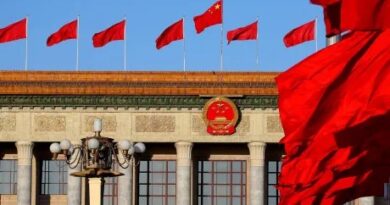Chinese way of reforms and openness. The Public Republic of China celebrates its 75th years Anniversary
This year the PRC celebrates its 75th years Anniversary. During these 75 years China managed to turn a poor and vulnerable country into the state with constantly developing economics.
Gross domestic product of the PRC since 1952 till 2003 has risen from 67,9 billion – to 126 trillion yuans. Index of GDP per capita since 1952 became 89 times more in real expression in terms of the average annual rates of rise equal to 6.5%.
If we take the period since the date of starting of political reforms and openness – indexes are higher. In 1979-2023 the average weighted rate of development of the national economics reached 8,5% annually, that is almost three time higher than the rate of rising of the world economics for the same period. The relative weight of China was increased in the world economics. If in 1978 the PRC covered only 1,7% of the global GDP, according to results of 2023 – it reached 17%. In 1978-2023 the PRC provided 24,8% of the global economic rise which is the highest indicator in the world.
The PRC was announced on the 1st of October, 1949, when socialism was elected as the fundamental structure. Sometimes later China weakened a role of the state sector in the economics, and opened the doors to foreign investments, invested big funds in developing of contemporary infrastructure.
This year this round date coincided with the 120th anniversary of birth of the chief architecture of reforms and openness of China Dan Xiaoping. According to the Professor of the I. Javakhishvili Tbilisi State University Ioseb Archvadze, the former leader of the PRC Dan Xiaoping should be named the architecture of the contemporary China. Communistic order is preserved in this state and it is a very interesting phenomena, – how harmonize communistic ideals with the terms of market competition.
“After collapsing of the Soviet Union, many theoreticians wrote that communism had not been a capable system. China proves opposite idea, that in terms of a leading role of the government and active social politics it is possible to provide a rapid rise of welfare of the whole nation and to monitor number of vulnerable and socially unprotected people. The remain world should look better on the economic reforms of China. And, to get a useful lesson that had been once made after the October’s Revolution of 1917 in Russia. Many capitalistic states being afraid of seizing of the power in hands by the working class, started large-scaled social reforms. Workers in the countries, such as Holland, France and particularly USA, namely became owners of definite benefits.
Generally, all this was made to prevent spreading of revolutionary moods in these countries. The XXI century rises new requirements and new challenges in direction of development of industry, science and technologies. China obtained and implemented licenses from leading countries on production in the fields of machine engineering, machine construction, device construction and demonstrated fine results. Recently, China solely develops new technologies which had become interesting in other states as well. I think that it is necessary to take these examples in consideration, to use the impressive results reached by China in economics. Today, the state occupies the second place in the world according to the economic development.
“In the long-termed prospect China will become the first economics of the world”, – thinks Ioseb Archvadze. Many researchers from different countries notice a great contribution in implementing of the so called “Chinese miracle” in the economics made by the state, political and party actor Dan Xiaoping. Dan Xiaoping became the author of the new thinking, initiator of economic reforms in China, developed a principle of the “socialism with the Chinese specifics” and turned this country into the part of the world market. Social-economic renovation of the country started in December, 1978. Main motivation of conducting of economic reforms became a necessity in higher efficiency and productivity, rising of a level of life of the population.
In the agricultural area a system of family service responsibility (privatization of farming) was implemented. China occupies the first place in the world in the field of agricultural production, in the sector more than 300 mln farmers are employed. In the urbanistic area special economic zones are opened as well as the access to the Chinese market for foreign investments, export-oriented economic strategy is developed. For 40 years more than 700 mln of Chinese people overcame poorness.
The government of the country promised, by the year of 2020, to overcome the poorness fully and fulfilled this promise. For the last eight years, 98,99 mln. poor agricultural people living under the line of poorness, improved their state. Thanks to such achievements China created another “miracle”, which will enter into the history, – says the Chairman Xi Jinping. Probably, we should add that China was well-known for its 4 greatest inventions – invention of paper, gunpowder, compass, and book printing. According to the official Chinese data, in 1820 China was covering of 30% of the world’s GDP. But, after the “Opium’s wars” of 1839-1860, the country gradually degraded and turned into the semi-colonialist and semi-feudal state.
After the period of anarchy, militarization, foreign oppression, civil war and Japanese occupation a share of China in the world production in 1949 fell down on the level less than 5%, and incomes of population reached 27 dollars, that was the lowest indicator in Asia.
In frames of the 75th anniversary, the chairman of China Xi Jinping stated that “there are no difficulties which can hinder progressing of the Chinese nation”. According to his, the Chinese nation for 75 years since the moment of foundation of the Public Republic of China, by way of integrating and leading of the multinational nation on the uninterruptable fight, created two miracles: rapid economic development and long-termed social stability.
Chairman of the PRC underlined that humanity lives on one world and all people from other states share a mutual fate. We should promote mutual values of the whole humanity, struggle for an equal and organized multipolar world and support building of the community of the united fate of the humanity. China suggested of the united project “One belt – one way”. This initiative is concluded in formation and promoting of a new model of international collaboration and development of almost all fields between different global civilizations. According to the official data, “One belt – one way” encompasses the largest part of Eurasia, uniting developing countries, including “new economics” and developed countries. On the territory of the megaproject resides about 63% of the world’s population, and an estimated economic scale amounts to 21 trillion US dollars.
Recently 136 countries and 30 international organization have already signed with the Beijing a document on cooperation in frames of the initiative “One belt – one way”. “One belt – one way” is the abbreviated name of two initiatives: “Economic Belt of the Silk Road” (EBSR) and the “Marine Silk Way of the XXI century” which were promoted by the Chairman of the PRC Xi Jinping in September-October, 2013 during the visits in the countries of the Central and Southern-Western Asia. The key content of the initiative consists of five issues: political coordination, mutual link of the infrastructure, uninterrupted trade, free movement of the capital and strengthening of relations between states.
The Professor Giorgi Abashishvili states: “Georgia considers important the initiative of the President of China Xi Jinping “One belt – one way” as the strategical location of our country provides an opportunity, using this initiative, to receive more benefit. We talk about sending of cargoes from China to the European states, and to pass their major part through Georgia as this road is the shortest, the most competitive and safe. For this purpose, we need more investments into the infrastructure. Georgia must focused on the Chinese-EU trade and gain more profits from the cargo transit. Georgia is the only one country in the region, which, on the first hand, has concluded an Agreement of Deep and Comprehensive Zone of Free Trade (DCFTA) with the EA and the agreement on free trade with China.
We should activate trading-economic relations with China, to continue the work with Chinese companies to attract more Chinese investments to Georgia which provide creation of the additional production in the country, and then its selling on the European market without any tariffs and different restriction. Experience of China is very interesting as the stated country managed to reach a storming economic rise. In some cases, when, for instance, we talk about encouraging of private investors, we should share the Chinese experience. In China many companies become successful, attract a large capital from the USA, and from the EU states. China created an interesting symbiose of two models which must be studied by economists.
In direction of improving of the transit function, Georgian constantly improves its traffic infrastructure (automobile, and railway). Every year Georgia increases the volume of the transited cargo. The main thing is that we should activate attracting of more private investments into the infrastructural projects. This investment must be made in a rapid speed for rapid developing and it needs not only state investments. The transit potential must be increased and the position of Georgia as of the logistical center must be strengthened to provide us with a larger benefit from this initiative”.
It is noteworthy that last year China and Georgia signed a treaty on strategic partnership. The Partnership includes the following four dimensions: political, economic, relations between people and cultural relations, international. The parties consider that since the moment of starting of diplomatic relations on the 9th of June, 1992, bilateral collaboration existing between two states brings fruitful results in different relations.
Particularly, the states plan to expand collaboration in the political, economic and cultural fields, to strengthen cooperation in international issues, to deepen bilateral relations and to provide mutually a regional and global peace, stability and development.
Today the Chinese companies invest in Georgia, actively cooperates with the Georgian party in the field of construction, agriculture, finances, communication and economic zones and supports developing of Chinese-Georgian relations. Good prospects are expected in the cultural cooperation. Thus, the former government of Georgia included teaching of Chinese language in the national system of education.
Lika Zhorzholiani



